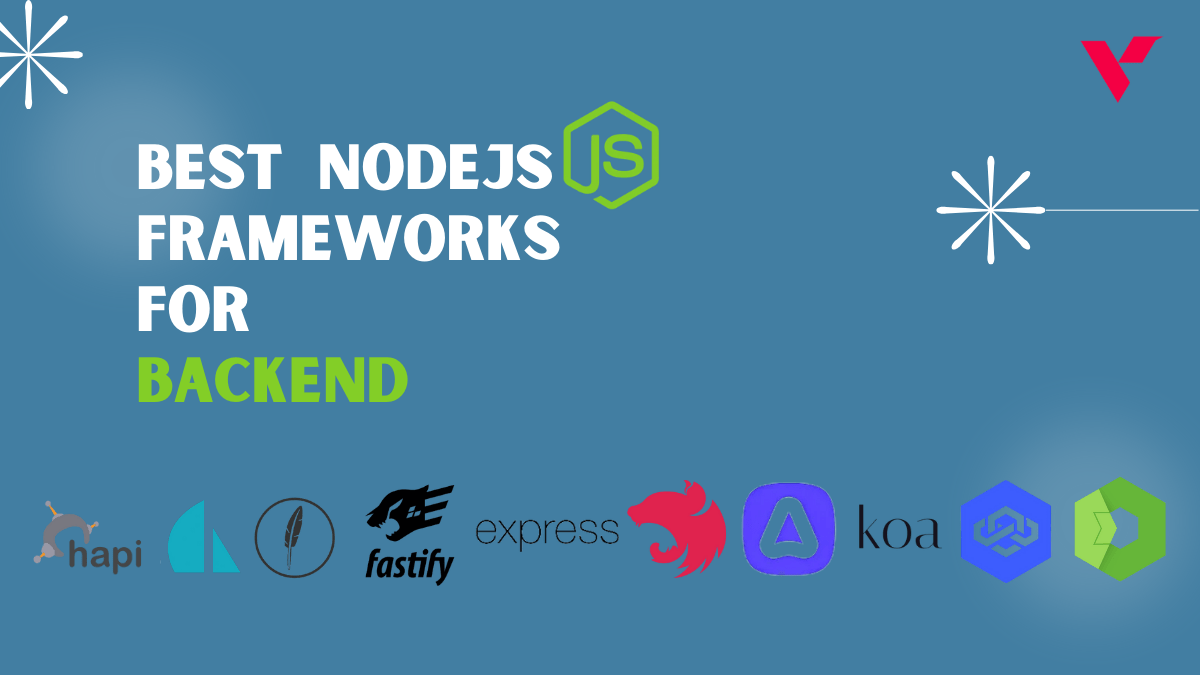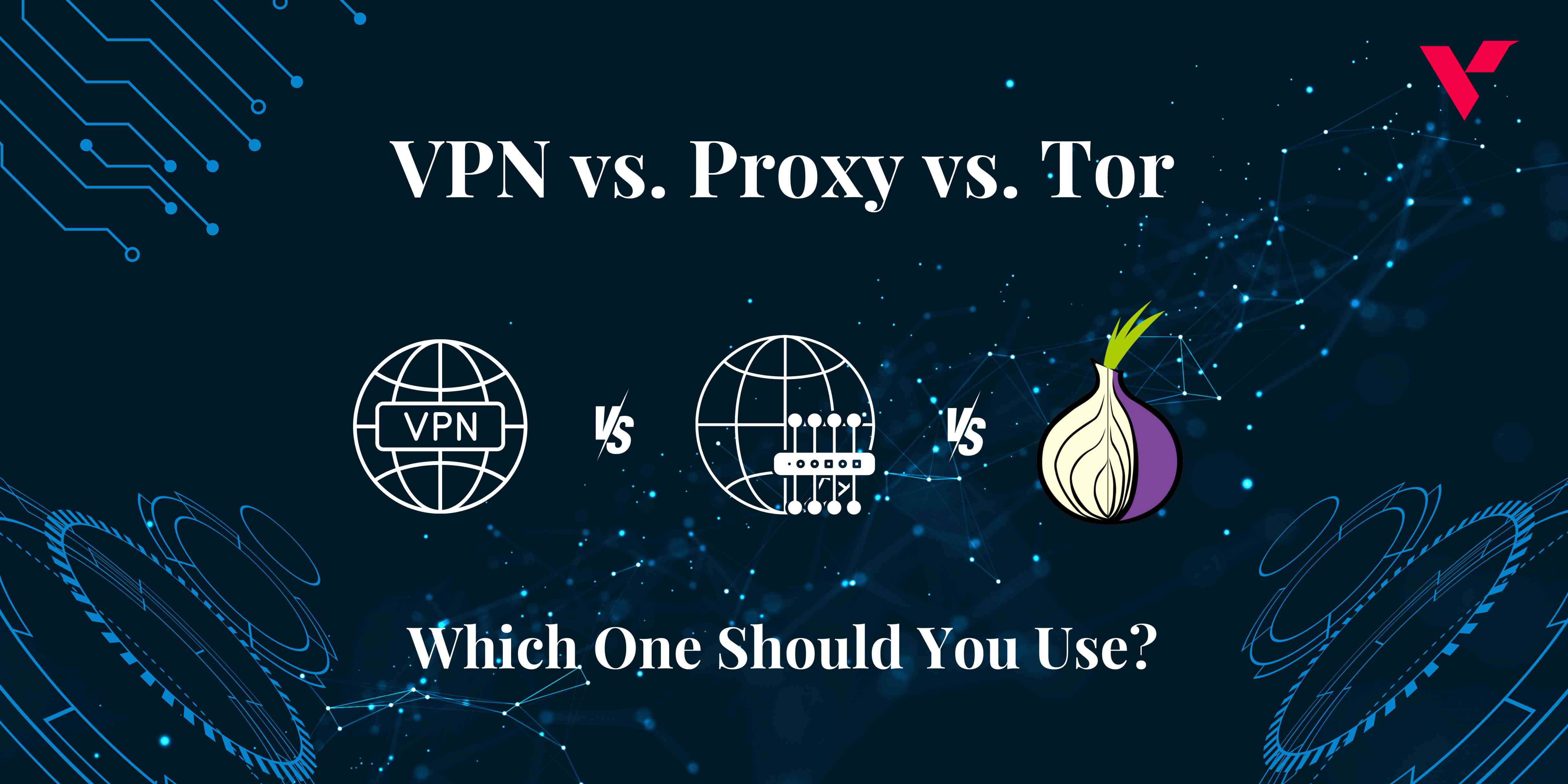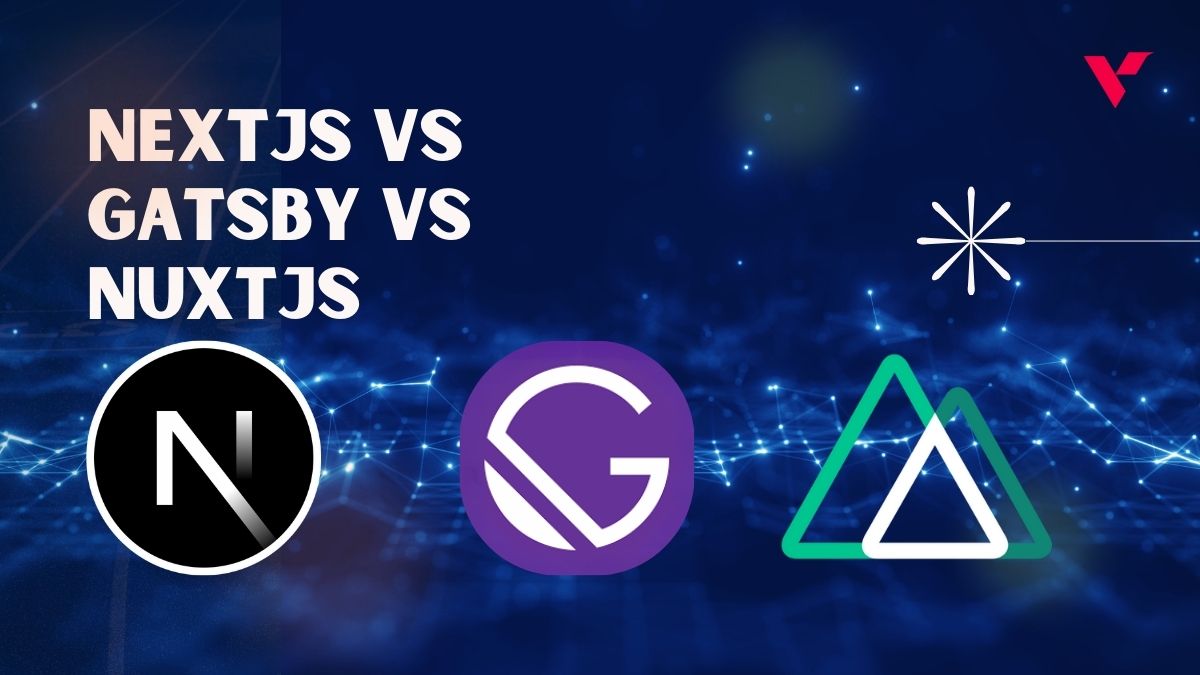Popular Tools by VOCSO
NodeJS has taken web development to next level, providing developers with a robust, efficient, and scalable platform for building backend applications. Unlike traditional server-side environments, NodeJS leverages JavaScript, a language traditionally used for client-side scripting, to create fast and scalable applications. NodeJS main advantage lies in its event-driven architecture and the non-blocking I/O model. This allows it to handle many simultaneous connections with high throughput, which is ideal for building real-time applications such as chat apps, gaming servers, and collaborative tools. But NodeJS alone does not make web development easy. It is the underlying frameworks that build on NodeJS or NodeJS Backend frameworks, providing structure, efficiency, and flexibility.
Table of Contents
Why Do NodeJS Frameworks Matter?
NodeJS is a low-level environment, and while it provides essential tools like an event loop and asynchronous I/O, building production-ready applications from scratch can be complex and time-consuming. This is where backend frameworks come in.
NodeJS frameworks abstract away many of the complexities of server-side programming. They provide built-in modules, conventions, and structures to help developers build applications faster and more efficiently. With a backend framework, developers can leverage pre-built solutions for routing, data management, authentication, middleware, and more.
Backend frameworks also come with libraries and plugins that handle common tasks, such as authentication, session management, and input validation. These frameworks help developers focus on creating business logic and application features, leaving much of the heavy lifting to the framework itself.
ExpressJS
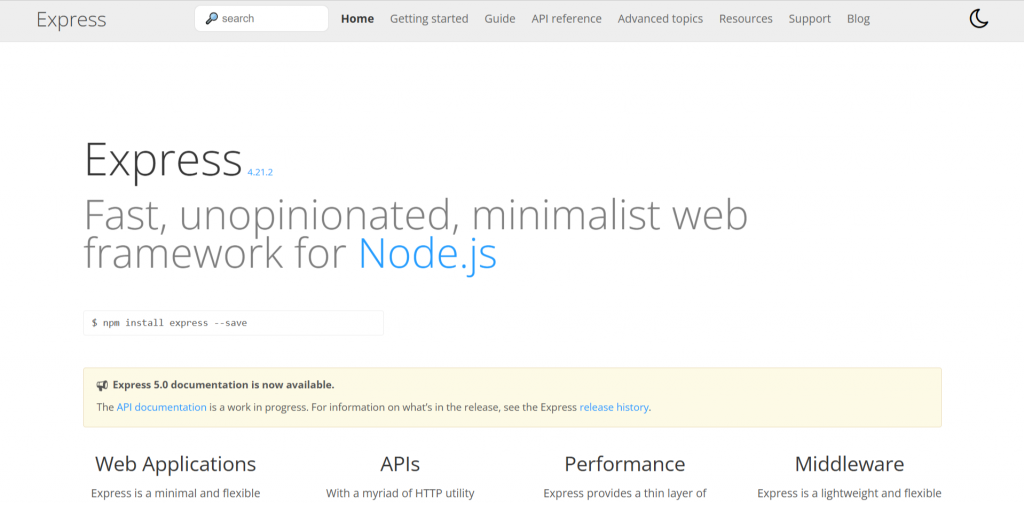
ExpressJS is a Classical Option and is one of the most widely-used backend frameworks for NodeJS, and it remains at the top of the stack. It is a minimalistic framework that focuses on providing essential features for building web and API applications. ExpressJS is known for its speed, simplicity, and flexibility, making it an excellent choice for developers looking for a no-fuss framework. Web Application Development is no more complex like before due to advancement of NodeJS Frameworks like ExpressJS which makes the development easier and productive.
Key Features:
Minimalist Design: ExpressJS provides a simple and lightweight structure. Developers can add only the features they need, making it highly customizable.
Routing: ExpressJS offers powerful routing features that allow developers to define routes for handling HTTP requests, such as GET, POST, PUT, DELETE, and more.
Middleware Support: ExpressJS allows developers to add middleware functions that can process requests before reaching the final route handler. This helps with tasks like request validation, error handling, and logging.
Template Engine Integration: ExpressJS integrates seamlessly with template engines like EJS and Pug, enabling the creation of dynamic web pages.
When to Use ExpressJS:
APIs: ExpressJS is ideal for building RESTful APIs due to its simplicity and speed.
Single-Page Applications (SPAs): ExpressJS works well with frontend frameworks like React and Angular to serve SPAs.
Microservices: Its lightweight nature makes ExpressJS a great choice for building microservices.
When Not to Use ExpressJS:
Large-scale Applications: ExpressJS is lightweight, but for larger applications that require more structure and scalability, other frameworks like NestJS may be more appropriate.
KoaJS

KoaJS is a relatively newer framework developed by the same team behind ExpressJS and is a modern Alternative to Express. While Express is simple and flexible, the Koa provide an even more lightweight and expressive alternative. It utilizes modern JavaScript features like async/await, making it a great choice for developers looking to take advantage of the latest JavaScript syntax.
Key Features:
Asynchronous Support: KoaJS embraces the use of async functions, allowing developers to write cleaner and more readable code without the need for callbacks.
Lightweight Core: Unlike Express, Koa doesn’t include a lot of built-in middleware. This gives developers greater flexibility to choose and add only the middleware they need.
Context Object: KoaJS uses a context object, which merges the request and response objects into a single object, streamlining how developers interact with HTTP requests.
When to Use KoaJS:
Building Scalable APIs: Koa’s lightweight and flexible design makes it a great choice for building scalable APIs that need to be customized with different middleware.
Real-time Applications: Koa’s asynchronous model and performance make it suitable for applications that require real-time data processing.
When Not to Use KoaJS:
Beginners: Koa’s learning curve can be steeper compared to ExpressJS. If your team is new to NodeJS or backend frameworks, Express might be a better starting point.
Full-Featured Applications: Koa is minimalistic by design, so if you need more built-in features and less customization, a more comprehensive framework like NestJS might be a better choice.
HapiJS
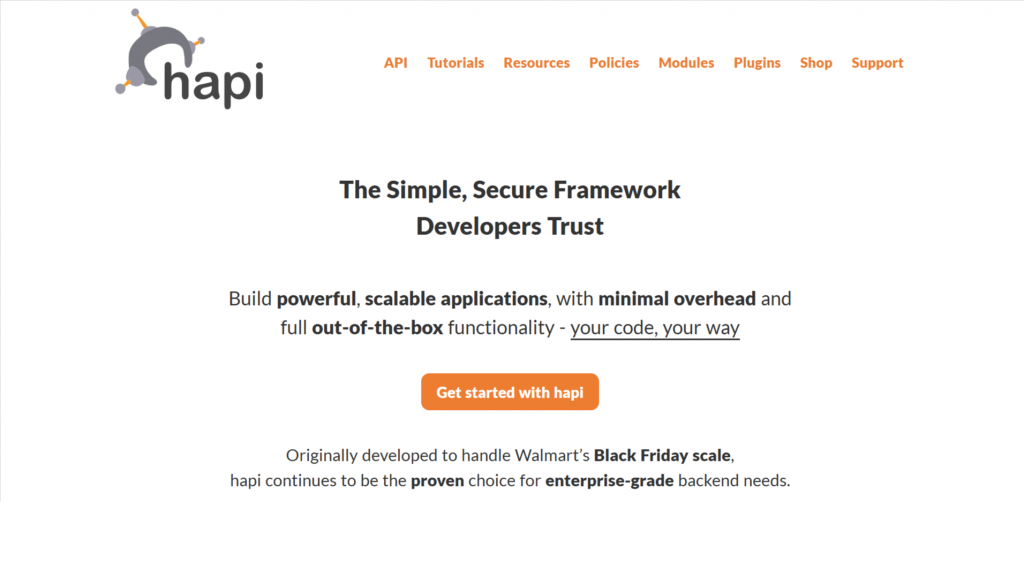
HapiJS is a powerful and highly customizable framework built keeping Security in mind that focuses on providing robust support for building secure applications. It is known for its rich plugin system and fine-grained control over request handling, validation, and error management.
Key Features:
Plugin System: HapiJS is built around a powerful plugin system, allowing developers to extend its capabilities as needed.
Input Validation: HapiJS comes with built-in support for validating user input, making it easier to prevent common security vulnerabilities such as SQL injection and cross-site scripting (XSS).
Routing and Lifecycle Hooks: HapiJS provides a flexible and highly configurable routing system, with lifecycle hooks for handling requests, responses, and errors at various stages.
Security: HapiJS has built-in features for securing applications, such as CSRF protection and input validation, making it a great choice for building secure APIs.
When to Use HapiJS:
Secure Applications: If your application handles sensitive data or requires robust security features, HapiJS is a great option due to its strong security features and input validation capabilities.
Complex Web Applications: HapiJS provides extensive configurability and is suitable for large and complex applications that require detailed control over routing, validation, and response handling.
When Not to Use HapiJS:
Simple Projects: HapiJS may be overkill for small, simple applications or APIs that don’t require extensive configuration or a large plugin ecosystem.
Performance-Intensive Applications: While HapiJS is feature-rich, it may not be the best option for highly performance-sensitive applications compared to more lightweight frameworks like KoaJS or ExpressJS.
NestJS
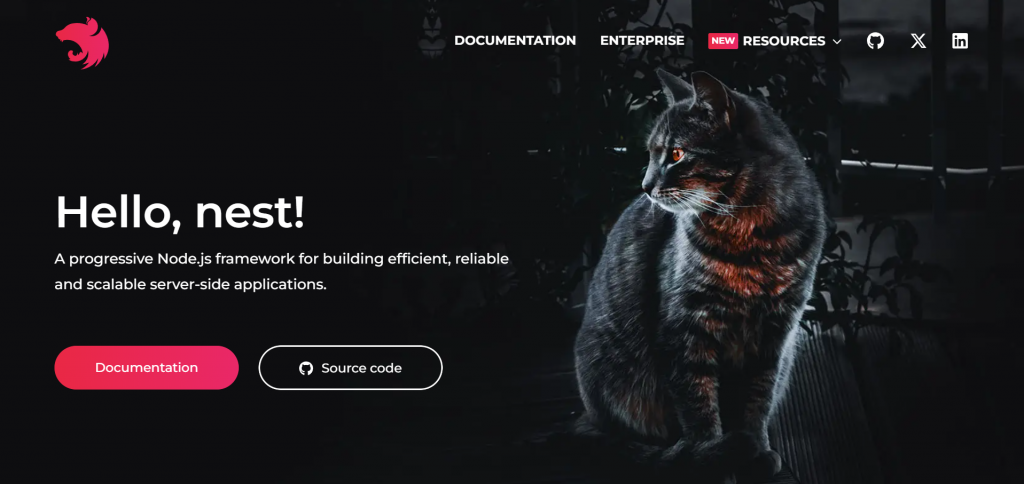
NestJS is a framework that combines the best features of OOP (Object-Oriented Programming), FP (Functional Programming), and Reactive Programming. It leverages TypeScript heavily and follows a modular approach to application structure. NestJS is built to scale and is ideal for building large, enterprise-grade applications or we can say that NestJS is ideal for Building Enterprise-Grade Applications with TypeScript.
Key Features:
TypeScript-first: NestJS is built with TypeScript in mind, providing strong typing and making it easier for developers to build reliable applications.
Modular Architecture: NestJS uses a modular architecture that allows developers to organize their applications into discrete modules, making the codebase more maintainable and scalable.
Dependency Injection: NestJS incorporates a powerful dependency injection system that allows developers to easily manage application services and resources.
Built-in Features: NestJS comes with built-in tools for routing, validation, authentication, and more. It also integrates well with other tools and libraries, such as TypeORM, GraphQL, and WebSockets.
When to Use NestJS:
Enterprise Applications: NestJS is ideal for building large, complex, and scalable enterprise applications due to its modularity and use of TypeScript.
APIs and Microservices: NestJS provides excellent support for building APIs and microservices, allowing for easy integration with other services and tools.
When Not to Use NestJS:
Small Projects: If you’re building a small, simple application or an API, NestJS may be overkill. For such cases, lightweight frameworks like ExpressJS or KoaJS may be more suitable.
Non-TypeScript Projects: If your team is not familiar with TypeScript or your project doesn’t require it, using a TypeScript-heavy framework like NestJS may not be ideal.
SailsJS
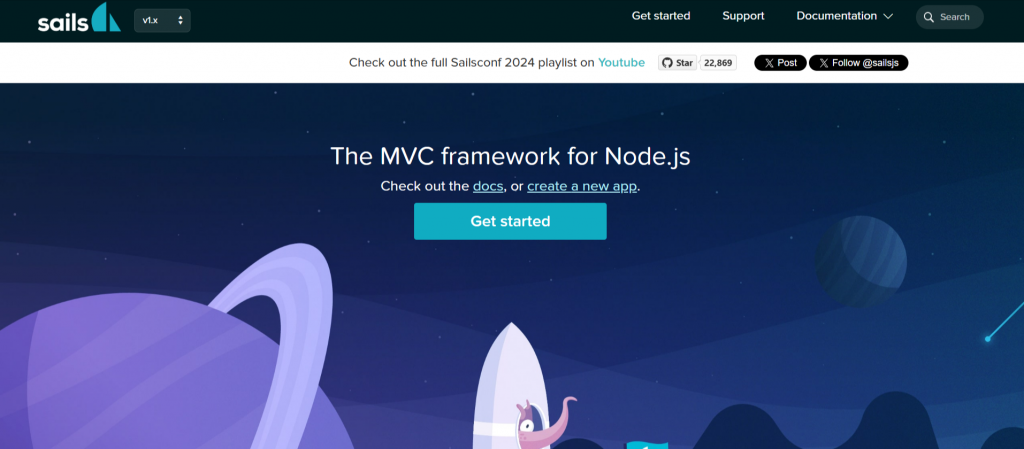
SailsJS is a full-featured framework built on top of ExpressJS, making it a great choice for building data-driven applications. It is particularly well-suited for applications that require real-time capabilities, such as chat applications or collaborative tools. SailsJS automatically generates RESTful APIs, making it a fast choice for developers.
Key Features:
Real-Time Capabilities: SailsJS has built-in support for WebSockets, making it an excellent choice for building real-time applications.
Automatic REST API Generation: SailsJS generates REST APIs automatically, saving developers time when building data-driven applications.
BluePrints: SailsJS comes with an integrated code generator called Blueprints, which allows developers to scaffold applications quickly and easily.
ORM/ODM: SailsJS includes the Waterline ORM, which makes it easy to interact with databases and manage data models.
When to Use SailsJS:
Real-Time Applications: SailsJS is well-suited for building applications that require real-time communication, such as chat apps and multiplayer games.
Data-Driven Applications: If your application heavily relies on data and needs to generate APIs quickly, SailsJS is a great choice.
When Not to Use SailsJS:
Simple Applications: SailsJS is a feature-rich framework and may be overkill for simpler applications or APIs.
Performance-Sensitive Applications: Due to its built-in features and abstraction, SailsJS might not be the best choice for performance-critical applications.
Fastify
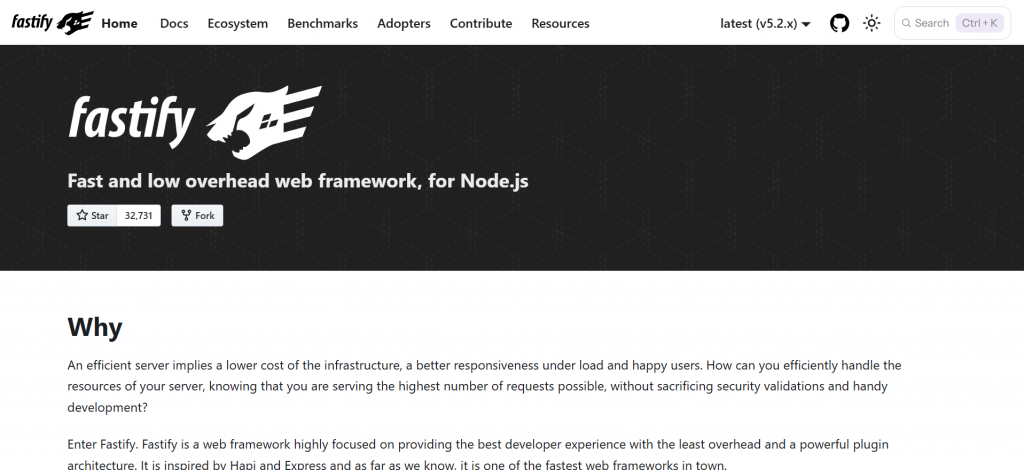
Fastify is a high-performance NodeJS framework that is designed for building fast and efficient web applications. It focuses on providing low overhead and high throughput, making it a great option for applications that need to handle a large number of requests per second. With its out of the box support for HTTP2 and schema-based validation, Fastify provides an excellent balance between performance and ease of use. NodeJS development is not difficult due to the advancement of frameworks like Fastify.
Key Features:
High Performance: Fastify is optimized for speed and can handle high throughput. It is one of the fastest NodeJS frameworks available, making it ideal for building performance-sensitive applications.
Schema-Based Validation: Fastify uses JSON schema-based validation, which makes it easier to define and validate request and response formats.
Extensible: Fastify is highly extensible, allowing developers to add custom plugins and integrate with various tools and libraries.
Built-in HTTP2 Support: Fastify supports HTTP2 out of the box, making it ideal for applications that need to take advantage of this modern protocol.
When to Use Fastify:
Performance-Critical Applications: If your application needs to handle a high volume of requests or requires minimal latency, Fastify is an excellent choice due to its high performance.
Microservices: Fastify is a great option for building microservices, thanks to its scalability, extensibility, and support for plugins.
When Not to Use Fastify:
Complex Applications: If you’re building a large, complex application with lots of business logic and features, you might prefer a more feature-rich framework like NestJS.
Learning Curve: While Fastify is easy to use for performance-focused developers, beginners might find it less intuitive compared to frameworks like ExpressJS.
AdonisJS
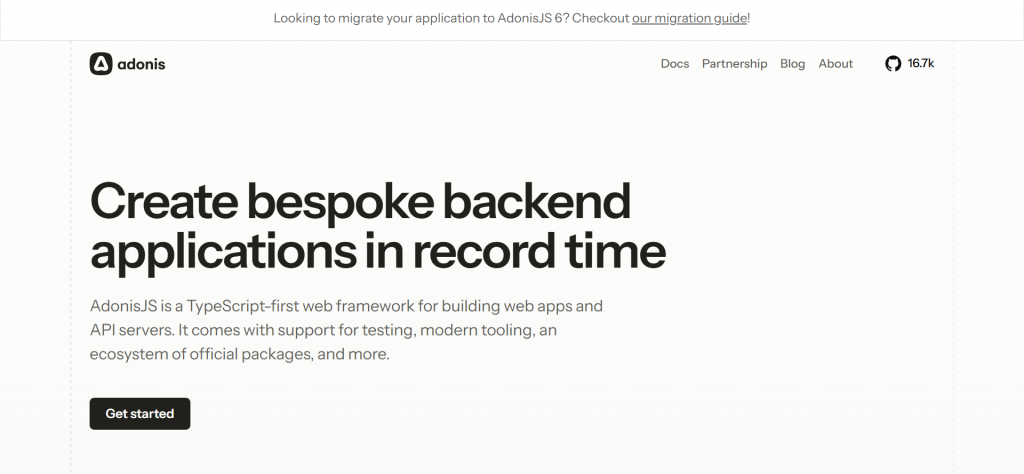
AdonisJS is a full-stack NodeJS framework that follows the Model-View-Controller (MVC) architecture pattern. It is designed to help developers build server-side applications quickly and efficiently by providing a lot of built-in functionality, such as authentication, database management, and validation.
AdonisJS is particularly popular among developers who prefer an opinionated framework that gives them a clear structure and conventions for building applications. It comes with a rich set of features, including a built-in ORM, request validation, and user authentication.
Key Features:
MVC Architecture: AdonisJS follows the MVC pattern, making it easy to organize and manage code. This pattern helps separate concerns and improves maintainability.
Built-in ORM: AdonisJS comes with its own ORM, which makes it easier to interact with databases and manage data models.
Authentication & Authorization: AdonisJS has built-in support for handling user authentication and authorization, including password hashing, sessions, and role-based access control (RBAC).
Extensive Documentation: AdonisJS provides thorough documentation and tutorials, which can be helpful for developers who are new to the framework.
When to Use AdonisJS:
Full-Stack Applications: If you’re building a full-stack application that requires backend and frontend logic, AdonisJS provides a comprehensive set of tools for building both.
Developers Who Prefer Structure: AdonisJS is ideal for developers who prefer a convention-over-configuration approach and want to get started quickly with a well-organized structure.
When Not to Use AdonisJS:
Customizability: If you prefer a more flexible, unopinionated framework, AdonisJS may feel restrictive. It follows specific conventions that may not be ideal for developers who want more freedom in how they structure their applications.
Microservices: If you’re building microservices or other lightweight, modular applications, a more minimalistic framework like KoaJS or Fastify might be a better choice.
LoopBack
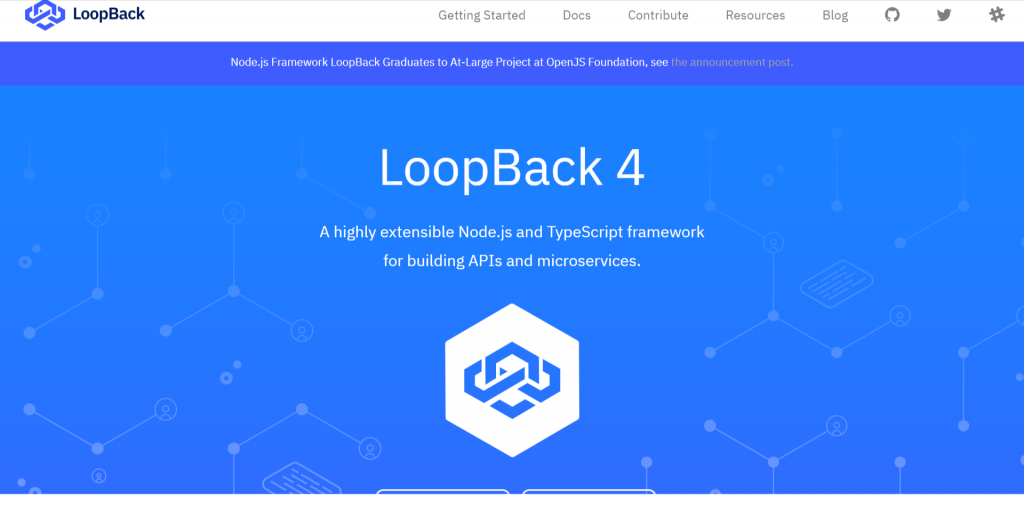
LoopBack is a highly extensible NodeJS framework that is focused on building API-driven applications. It provides a powerful set of tools for creating RESTful APIs, connecting to databases, and integrating with external services. LoopBack’s strong emphasis on API development and its support for complex use cases make it an excellent choice for building robust and scalable APIs. The Backend Development is getting simple as the newer frameworks like the LoopBack are getting built.
Key Features:
API Generation: LoopBack allows you to generate RESTful APIs with minimal configuration quickly. It comes with built-in support for various data sources, such as SQL and NoSQL databases.
Modeling: LoopBack includes a powerful ORM called LoopBack 4, which helps you define models and relations between them. This simplifies data management and makes it easier to work with databases.
Extensible: LoopBack is highly extensible, allowing developers to add custom components, connectors, and services.
API Explorer: LoopBack includes an integrated API Explorer, which allows developers to test and interact with APIs directly from the browser.
When to Use LoopBack:
API-First Applications: If you’re building an application where the backend is primarily an API, LoopBack is a great choice. It is mostly used for generating/ managing APIs and microservices.
Complex Data Models: LoopBack is well-suited for applications that involve complex data models, thanks to its powerful ORM and support for defining model relations.
Service Integration: If your application needs to connect to multiple external services or data sources, LoopBack’s extensibility and connectors make it easy to integrate with third-party services.
When Not to Use LoopBack:
Small Projects: If you’re building a small project that doesn’t require advanced API features, LoopBack may be overkill. For simpler applications, a lighter framework like ExpressJS or KoaJS might be more appropriate.
Performance-Sensitive Applications: LoopBack is a feature-rich framework, and while it’s powerful, it may not be as lightweight and fast as frameworks like Fastify for performance-critical applications.
FeatherJS
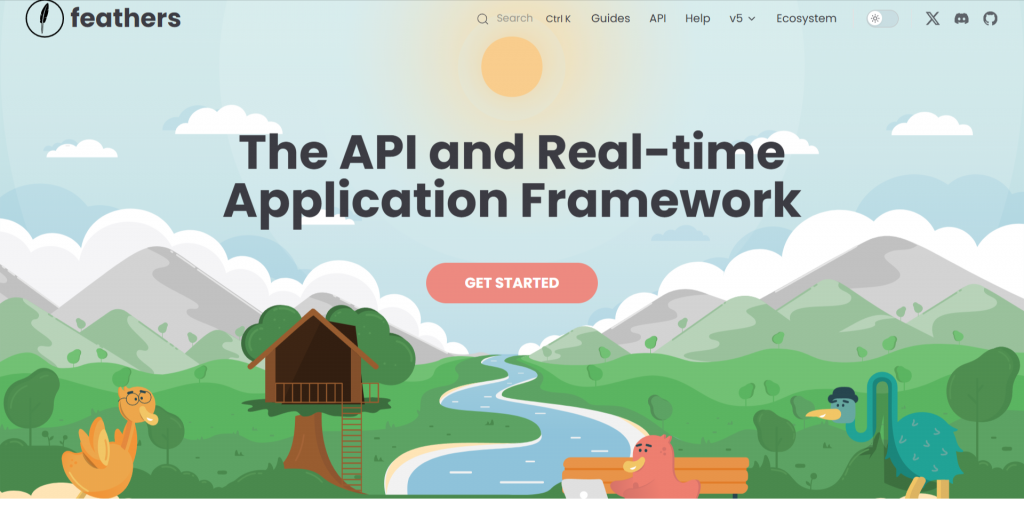
FeatherJS or Feathers is a minimalistic and highly flexible framework designed for building real-time applications. It is particularly useful for developing APIs and microservices that require low latency and high scalability. FeatherJS is built to be simple, yet highly customizable, allowing developers to create applications that suit their specific needs. Custom API Development is getting easier due to API focused frameworks like the FeatherJS/ Feathers which make the backend development fast and easier.
Key Features:
Real-Time Support: FeatherJS has built-in support for real-time communication, making it an excellent choice for chat apps, collaborative tools, and other real-time applications.
Extensibility: FeatherJS is highly extensible, allowing developers to integrate custom services, hooks, and middleware.
Microservice-Friendly: FeatherJS is lightweight and can be easily used to create microservices that are modular and scalable.
Support for Multiple Databases: FeatherJS supports multiple databases, including SQL and NoSQL databases, and allows you to switch between them without changing much of your code.
When to Use FeatherJS:
Real-Time Applications: FeatherJS is ideal for building real-time applications, such as messaging platforms, collaborative tools, or gaming servers.
Microservices: FeatherJS lightweight nature makes it an excellent choice for building microservices and distributed applications that need to be scalable and easy to maintain.
When Not to Use FeatherJS:
Full-Featured Applications: FeatherJS is minimalistic and doesn’t come with as many built-in features as other frameworks like NestJS or SailsJS. If you need a more full-featured framework, you might prefer one of those options.
Beginners: FeatherJS requires a bit more setup and configuration compared to more beginner-friendly frameworks like ExpressJS.
TotalJS
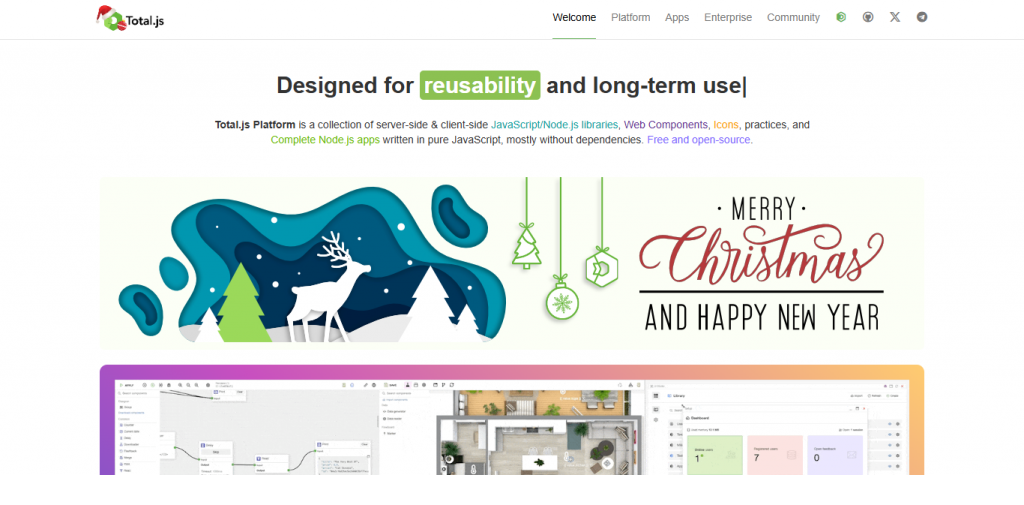
TotalJS is a NodeJS framework that offers a wide array of features for building modern web applications. It provides a collection of server-side and client-side JavaScript libraries, UI components, and complete products, all written in pure JavaScript without third-party dependencies.
Key Features:
No Dependencies: TotalJS operates without third-party dependencies, allowing developers to use any NPM module or existing client-side libraries as needed.
Rapid Development: The platform is optimized for quick development cycles, offering tools like the TotalJS Code Editor and project templates to streamline the development process.
Visual Programming Interface: TotalJS includes visual programming interfaces such as TotalJS Flow, AppBuilder, and Designer, enabling developers to create applications through intuitive, drag-and-drop interfaces.
Modularity: The framework supports modular development, allowing applications to be divided into reusable modules for better code management and maintenance.
Performance: TotalJS is known for its impressive performance, capable of handling hundreds of requests per second on a single thread. For higher scalability, it supports clustering and threading.
When to Use TotalJS:
Rapid Prototyping: Its suite of tools and pre-built modules make TotalJS ideal for quickly developing prototypes and MVPs.
Modular Applications: If your project requires a modular architecture for better code organization and maintainability, TotalJS support for modular development is beneficial.
Visual Development: For projects that can benefit from visual programming interfaces, TotalJS offers tools like Flow and AppBuilder to facilitate this approach.
When Not to Use TotalJS:
Full-Featured Frameworks: If your project demands a framework with a vast ecosystem and extensive built-in features, you might consider alternatives like NestJS or SailsJS.
Beginner-Friendly Frameworks: TotalJS unique architecture and lack of third-party dependencies might present a steeper learning curve for beginners compared to more widely adopted frameworks like ExpressJS.
Conclusion
When it comes to choosing the right NodeJS backend framework, there is no one-size-fits-all solution. The best framework for your project will depend on factors such as the complexity of your application, your team’s familiarity with specific tools, and the scalability requirements of your system. Among the frameworks above, SailsJS, NestJS, and FeathersJS are built on top of ExpressJS.
For simplicity and flexibility: ExpressJS is a great choice for small to medium-sized projects, and it’s perfect for developers who need full control over their application’s structure.
For modern and scalable apps: KoaJS and Fastify provide great performance and scalability, while Koa’s async/await model makes it ideal for real-time applications.
For enterprise-grade apps: NestJS offers a structured approach to building large applications, and it is highly extensible and ideal for TypeScript developers.
For secure APIs and applications: HapiJS excels in building secure applications, with built-in features to prevent common security issues.
For data-driven applications: SailsJS is an excellent choice, offering automatic REST API generation and real-time capabilities out of the box.
For full-stack solutions: AdonisJS provides a comprehensive framework with built-in features for both backend and frontend development.
The key to making the right choice is understanding your project’s unique needs. Whether you prioritize performance, simplicity, security, or scalability, NodeJS frameworks provide a wide range of options to suit different development goals. Ultimately, it’s not just about selecting a framework but also about how well it integrates with your development stack and aligns with your project’s objectives. Whatever framework you choose, NodeJS will remain a powerful tool for building scalable, efficient, and modern web applications.


